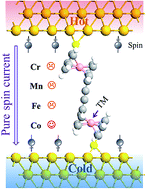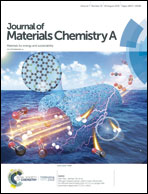Pure spin current generated in thermally driven molecular magnetic junctions: a promising mechanism for thermoelectric conversion†
Abstract
Pure spin current is expected to be utilized for designing energy-saving devices. Using first-principles calculations in combination with a non-equilibrium Green's function method, the spin-dependent thermoelectric transport properties of metallocene dimer-based molecular junctions are investigated. The results show that spin-polarized currents can be achieved when a temperature difference is applied in molecular structures. It is found that the spin-polarized transport properties are different when transition metals in the dimers are different. It is interesting that a negative differential thermoelectric resistance and a perfect spin filtering effect can be found in chromocene dimer-based and manganocene dimer-based molecular junctions. Moreover, one key finding is that a pure spin current can be obtained in a cobaltocene dimer-based molecular junction, in which the spin-dependent Seebeck coefficient is larger than the charge Seebeck coefficient. These interesting results indicate that metallocene dimer-based molecular junctions have potential applications in future thermal spintronic and spin thermoelectric devices.

- This article is part of the themed collection: 2019 Journal of Materials Chemistry A Most Popular Articles


 Please wait while we load your content...
Please wait while we load your content...